Ethical Principles of Belmont Report and Current Research Practices
VerifiedAdded on 2023/01/20
|9
|2233
|53
Essay
AI Summary
This essay explores the Belmont Report, a cornerstone in research ethics, and its impact on contemporary research practices. The essay delves into the report's core ethical principles: beneficence, justice, and respect for persons (autonomy), highlighting their significance in protecting research participants' rights and well-being. It also examines the application of these principles in modern research settings, with a focus on informed consent, risk-benefit assessment, and participant selection. Furthermore, the essay discusses the 'Common Rule,' and its revisions, demonstrating how these changes aim to balance ethical considerations with the practicalities of research, particularly in government-funded studies. The analysis includes the concept of autonomy and its relevance to current research, especially in areas like cancer and terminal diseases. The essay also addresses the principles of beneficence, non-maleficence, and justice, illustrating how the Common Rule and its revisions aim to ensure ethical conduct and participant protection in research. The essay concludes by emphasizing the Belmont Report's enduring importance in guiding ethical research practices.

Running head: ESSAY
Belmont Report
Name of the Student
Name of the University
Author Note
Belmont Report
Name of the Student
Name of the University
Author Note
Paraphrase This Document
Need a fresh take? Get an instant paraphrase of this document with our AI Paraphraser
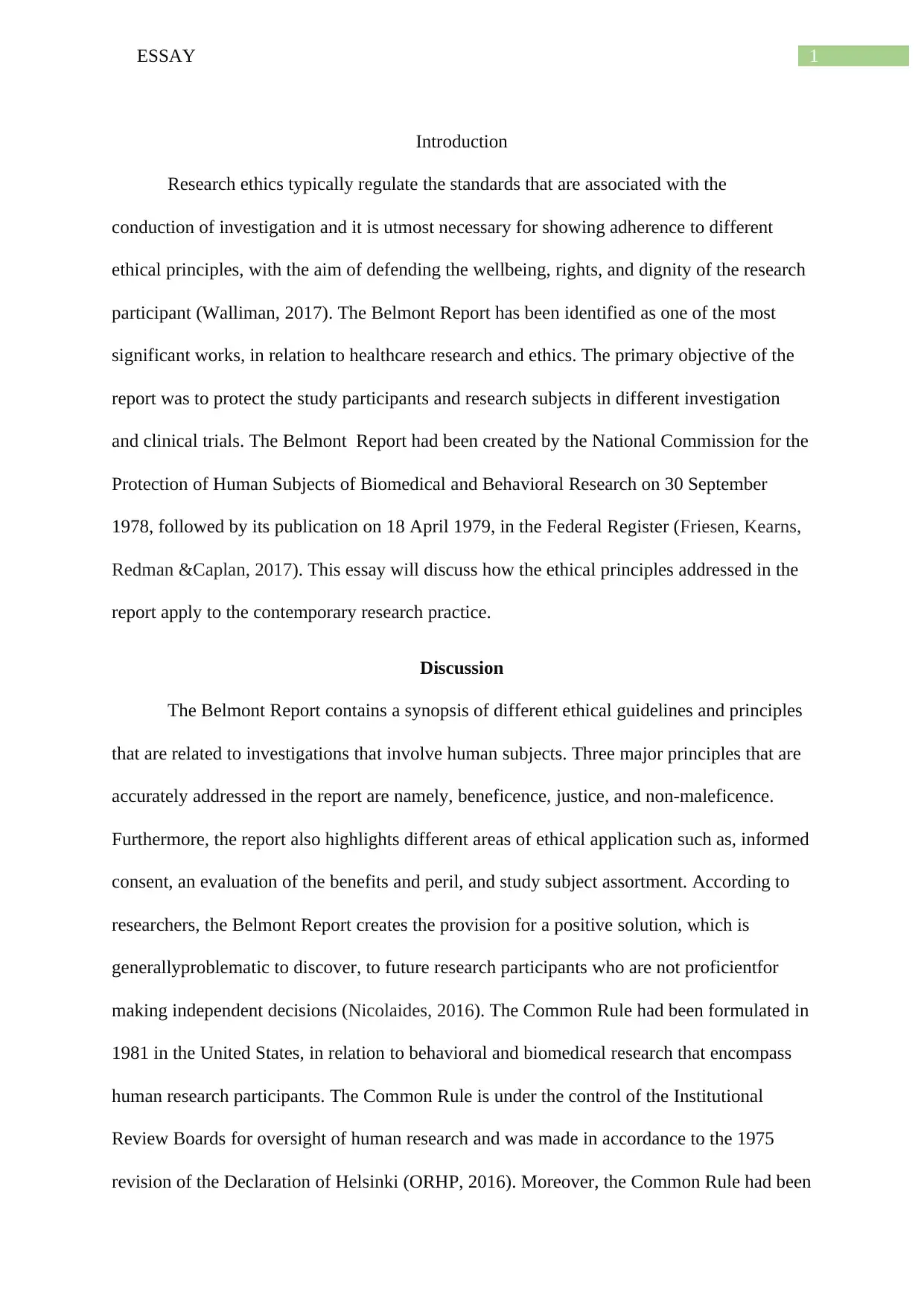
1ESSAY
Introduction
Research ethics typically regulate the standards that are associated with the
conduction of investigation and it is utmost necessary for showing adherence to different
ethical principles, with the aim of defending the wellbeing, rights, and dignity of the research
participant (Walliman, 2017). The Belmont Report has been identified as one of the most
significant works, in relation to healthcare research and ethics. The primary objective of the
report was to protect the study participants and research subjects in different investigation
and clinical trials. The Belmont Report had been created by the National Commission for the
Protection of Human Subjects of Biomedical and Behavioral Research on 30 September
1978, followed by its publication on 18 April 1979, in the Federal Register (Friesen, Kearns,
Redman &Caplan, 2017). This essay will discuss how the ethical principles addressed in the
report apply to the contemporary research practice.
Discussion
The Belmont Report contains a synopsis of different ethical guidelines and principles
that are related to investigations that involve human subjects. Three major principles that are
accurately addressed in the report are namely, beneficence, justice, and non-maleficence.
Furthermore, the report also highlights different areas of ethical application such as, informed
consent, an evaluation of the benefits and peril, and study subject assortment. According to
researchers, the Belmont Report creates the provision for a positive solution, which is
generallyproblematic to discover, to future research participants who are not proficientfor
making independent decisions (Nicolaides, 2016). The Common Rule had been formulated in
1981 in the United States, in relation to behavioral and biomedical research that encompass
human research participants. The Common Rule is under the control of the Institutional
Review Boards for oversight of human research and was made in accordance to the 1975
revision of the Declaration of Helsinki (ORHP, 2016). Moreover, the Common Rule had been
Introduction
Research ethics typically regulate the standards that are associated with the
conduction of investigation and it is utmost necessary for showing adherence to different
ethical principles, with the aim of defending the wellbeing, rights, and dignity of the research
participant (Walliman, 2017). The Belmont Report has been identified as one of the most
significant works, in relation to healthcare research and ethics. The primary objective of the
report was to protect the study participants and research subjects in different investigation
and clinical trials. The Belmont Report had been created by the National Commission for the
Protection of Human Subjects of Biomedical and Behavioral Research on 30 September
1978, followed by its publication on 18 April 1979, in the Federal Register (Friesen, Kearns,
Redman &Caplan, 2017). This essay will discuss how the ethical principles addressed in the
report apply to the contemporary research practice.
Discussion
The Belmont Report contains a synopsis of different ethical guidelines and principles
that are related to investigations that involve human subjects. Three major principles that are
accurately addressed in the report are namely, beneficence, justice, and non-maleficence.
Furthermore, the report also highlights different areas of ethical application such as, informed
consent, an evaluation of the benefits and peril, and study subject assortment. According to
researchers, the Belmont Report creates the provision for a positive solution, which is
generallyproblematic to discover, to future research participants who are not proficientfor
making independent decisions (Nicolaides, 2016). The Common Rule had been formulated in
1981 in the United States, in relation to behavioral and biomedical research that encompass
human research participants. The Common Rule is under the control of the Institutional
Review Boards for oversight of human research and was made in accordance to the 1975
revision of the Declaration of Helsinki (ORHP, 2016). Moreover, the Common Rule had been
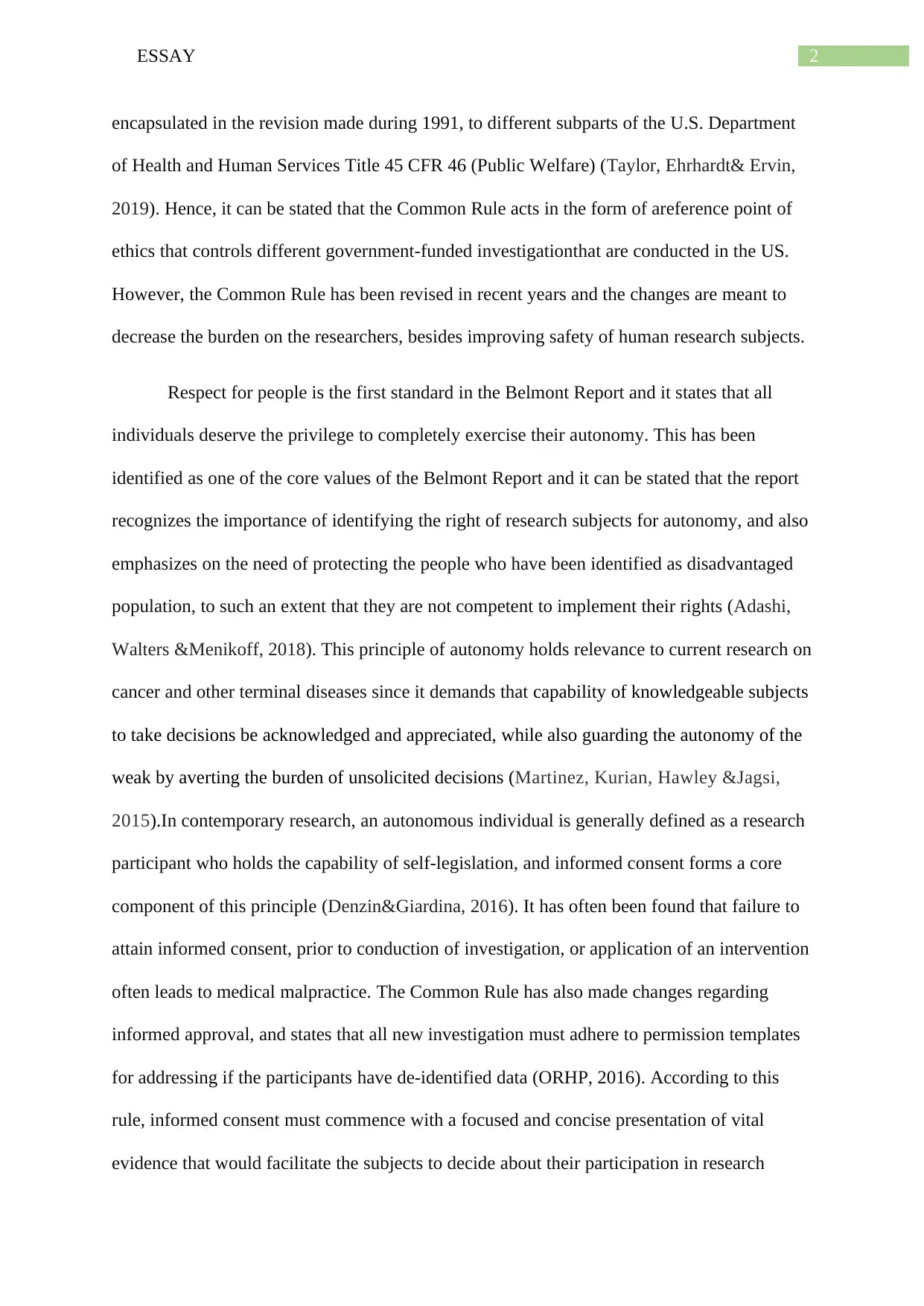
2ESSAY
encapsulated in the revision made during 1991, to different subparts of the U.S. Department
of Health and Human Services Title 45 CFR 46 (Public Welfare) (Taylor, Ehrhardt& Ervin,
2019). Hence, it can be stated that the Common Rule acts in the form of areference point of
ethics that controls different government-funded investigationthat are conducted in the US.
However, the Common Rule has been revised in recent years and the changes are meant to
decrease the burden on the researchers, besides improving safety of human research subjects.
Respect for people is the first standard in the Belmont Report and it states that all
individuals deserve the privilege to completely exercise their autonomy. This has been
identified as one of the core values of the Belmont Report and it can be stated that the report
recognizes the importance of identifying the right of research subjects for autonomy, and also
emphasizes on the need of protecting the people who have been identified as disadvantaged
population, to such an extent that they are not competent to implement their rights (Adashi,
Walters &Menikoff, 2018). This principle of autonomy holds relevance to current research on
cancer and other terminal diseases since it demands that capability of knowledgeable subjects
to take decisions be acknowledged and appreciated, while also guarding the autonomy of the
weak by averting the burden of unsolicited decisions (Martinez, Kurian, Hawley &Jagsi,
2015).In contemporary research, an autonomous individual is generally defined as a research
participant who holds the capability of self-legislation, and informed consent forms a core
component of this principle (Denzin&Giardina, 2016). It has often been found that failure to
attain informed consent, prior to conduction of investigation, or application of an intervention
often leads to medical malpractice. The Common Rule has also made changes regarding
informed approval, and states that all new investigation must adhere to permission templates
for addressing if the participants have de-identified data (ORHP, 2016). According to this
rule, informed consent must commence with a focused and concise presentation of vital
evidence that would facilitate the subjects to decide about their participation in research
encapsulated in the revision made during 1991, to different subparts of the U.S. Department
of Health and Human Services Title 45 CFR 46 (Public Welfare) (Taylor, Ehrhardt& Ervin,
2019). Hence, it can be stated that the Common Rule acts in the form of areference point of
ethics that controls different government-funded investigationthat are conducted in the US.
However, the Common Rule has been revised in recent years and the changes are meant to
decrease the burden on the researchers, besides improving safety of human research subjects.
Respect for people is the first standard in the Belmont Report and it states that all
individuals deserve the privilege to completely exercise their autonomy. This has been
identified as one of the core values of the Belmont Report and it can be stated that the report
recognizes the importance of identifying the right of research subjects for autonomy, and also
emphasizes on the need of protecting the people who have been identified as disadvantaged
population, to such an extent that they are not competent to implement their rights (Adashi,
Walters &Menikoff, 2018). This principle of autonomy holds relevance to current research on
cancer and other terminal diseases since it demands that capability of knowledgeable subjects
to take decisions be acknowledged and appreciated, while also guarding the autonomy of the
weak by averting the burden of unsolicited decisions (Martinez, Kurian, Hawley &Jagsi,
2015).In contemporary research, an autonomous individual is generally defined as a research
participant who holds the capability of self-legislation, and informed consent forms a core
component of this principle (Denzin&Giardina, 2016). It has often been found that failure to
attain informed consent, prior to conduction of investigation, or application of an intervention
often leads to medical malpractice. The Common Rule has also made changes regarding
informed approval, and states that all new investigation must adhere to permission templates
for addressing if the participants have de-identified data (ORHP, 2016). According to this
rule, informed consent must commence with a focused and concise presentation of vital
evidence that would facilitate the subjects to decide about their participation in research
⊘ This is a preview!⊘
Do you want full access?
Subscribe today to unlock all pages.

Trusted by 1+ million students worldwide
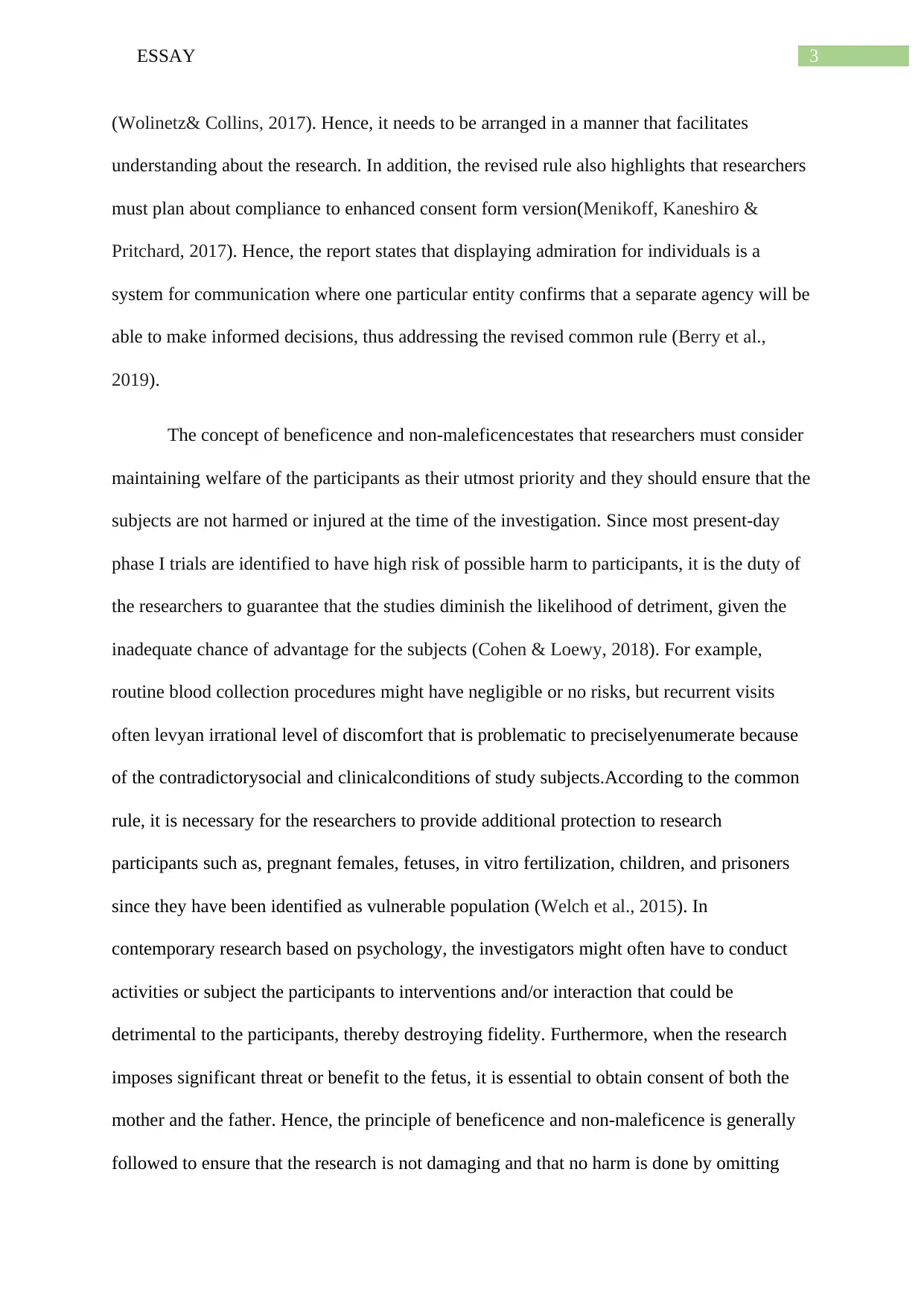
3ESSAY
(Wolinetz& Collins, 2017). Hence, it needs to be arranged in a manner that facilitates
understanding about the research. In addition, the revised rule also highlights that researchers
must plan about compliance to enhanced consent form version(Menikoff, Kaneshiro &
Pritchard, 2017). Hence, the report states that displaying admiration for individuals is a
system for communication where one particular entity confirms that a separate agency will be
able to make informed decisions, thus addressing the revised common rule (Berry et al.,
2019).
The concept of beneficence and non-maleficencestates that researchers must consider
maintaining welfare of the participants as their utmost priority and they should ensure that the
subjects are not harmed or injured at the time of the investigation. Since most present-day
phase I trials are identified to have high risk of possible harm to participants, it is the duty of
the researchers to guarantee that the studies diminish the likelihood of detriment, given the
inadequate chance of advantage for the subjects (Cohen & Loewy, 2018). For example,
routine blood collection procedures might have negligible or no risks, but recurrent visits
often levyan irrational level of discomfort that is problematic to preciselyenumerate because
of the contradictorysocial and clinicalconditions of study subjects.According to the common
rule, it is necessary for the researchers to provide additional protection to research
participants such as, pregnant females, fetuses, in vitro fertilization, children, and prisoners
since they have been identified as vulnerable population (Welch et al., 2015). In
contemporary research based on psychology, the investigators might often have to conduct
activities or subject the participants to interventions and/or interaction that could be
detrimental to the participants, thereby destroying fidelity. Furthermore, when the research
imposes significant threat or benefit to the fetus, it is essential to obtain consent of both the
mother and the father. Hence, the principle of beneficence and non-maleficence is generally
followed to ensure that the research is not damaging and that no harm is done by omitting
(Wolinetz& Collins, 2017). Hence, it needs to be arranged in a manner that facilitates
understanding about the research. In addition, the revised rule also highlights that researchers
must plan about compliance to enhanced consent form version(Menikoff, Kaneshiro &
Pritchard, 2017). Hence, the report states that displaying admiration for individuals is a
system for communication where one particular entity confirms that a separate agency will be
able to make informed decisions, thus addressing the revised common rule (Berry et al.,
2019).
The concept of beneficence and non-maleficencestates that researchers must consider
maintaining welfare of the participants as their utmost priority and they should ensure that the
subjects are not harmed or injured at the time of the investigation. Since most present-day
phase I trials are identified to have high risk of possible harm to participants, it is the duty of
the researchers to guarantee that the studies diminish the likelihood of detriment, given the
inadequate chance of advantage for the subjects (Cohen & Loewy, 2018). For example,
routine blood collection procedures might have negligible or no risks, but recurrent visits
often levyan irrational level of discomfort that is problematic to preciselyenumerate because
of the contradictorysocial and clinicalconditions of study subjects.According to the common
rule, it is necessary for the researchers to provide additional protection to research
participants such as, pregnant females, fetuses, in vitro fertilization, children, and prisoners
since they have been identified as vulnerable population (Welch et al., 2015). In
contemporary research based on psychology, the investigators might often have to conduct
activities or subject the participants to interventions and/or interaction that could be
detrimental to the participants, thereby destroying fidelity. Furthermore, when the research
imposes significant threat or benefit to the fetus, it is essential to obtain consent of both the
mother and the father. Hence, the principle of beneficence and non-maleficence is generally
followed to ensure that the research is not damaging and that no harm is done by omitting
Paraphrase This Document
Need a fresh take? Get an instant paraphrase of this document with our AI Paraphraser
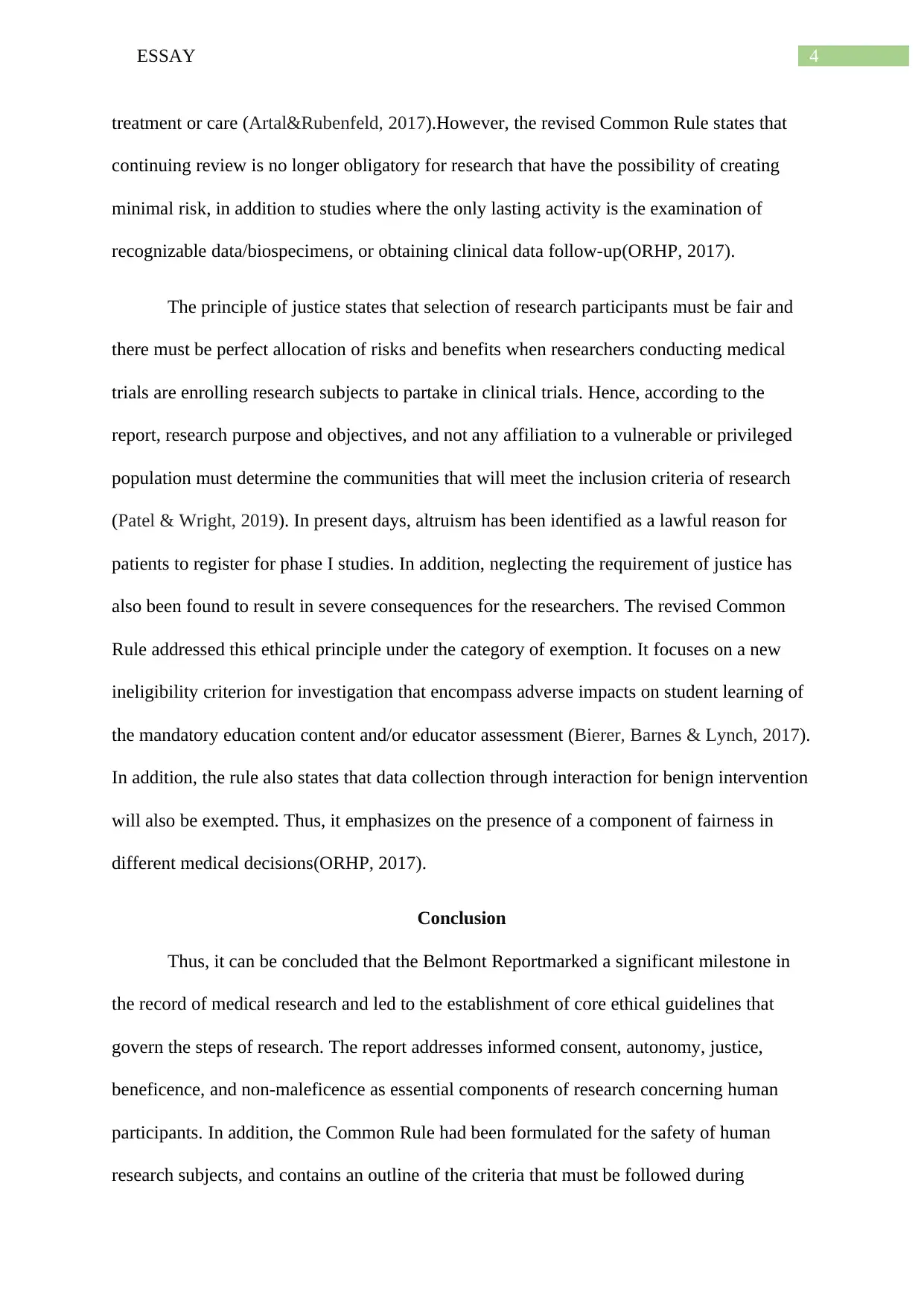
4ESSAY
treatment or care (Artal&Rubenfeld, 2017).However, the revised Common Rule states that
continuing review is no longer obligatory for research that have the possibility of creating
minimal risk, in addition to studies where the only lasting activity is the examination of
recognizable data/biospecimens, or obtaining clinical data follow-up(ORHP, 2017).
The principle of justice states that selection of research participants must be fair and
there must be perfect allocation of risks and benefits when researchers conducting medical
trials are enrolling research subjects to partake in clinical trials. Hence, according to the
report, research purpose and objectives, and not any affiliation to a vulnerable or privileged
population must determine the communities that will meet the inclusion criteria of research
(Patel & Wright, 2019). In present days, altruism has been identified as a lawful reason for
patients to register for phase I studies. In addition, neglecting the requirement of justice has
also been found to result in severe consequences for the researchers. The revised Common
Rule addressed this ethical principle under the category of exemption. It focuses on a new
ineligibility criterion for investigation that encompass adverse impacts on student learning of
the mandatory education content and/or educator assessment (Bierer, Barnes & Lynch, 2017).
In addition, the rule also states that data collection through interaction for benign intervention
will also be exempted. Thus, it emphasizes on the presence of a component of fairness in
different medical decisions(ORHP, 2017).
Conclusion
Thus, it can be concluded that the Belmont Reportmarked a significant milestone in
the record of medical research and led to the establishment of core ethical guidelines that
govern the steps of research. The report addresses informed consent, autonomy, justice,
beneficence, and non-maleficence as essential components of research concerning human
participants. In addition, the Common Rule had been formulated for the safety of human
research subjects, and contains an outline of the criteria that must be followed during
treatment or care (Artal&Rubenfeld, 2017).However, the revised Common Rule states that
continuing review is no longer obligatory for research that have the possibility of creating
minimal risk, in addition to studies where the only lasting activity is the examination of
recognizable data/biospecimens, or obtaining clinical data follow-up(ORHP, 2017).
The principle of justice states that selection of research participants must be fair and
there must be perfect allocation of risks and benefits when researchers conducting medical
trials are enrolling research subjects to partake in clinical trials. Hence, according to the
report, research purpose and objectives, and not any affiliation to a vulnerable or privileged
population must determine the communities that will meet the inclusion criteria of research
(Patel & Wright, 2019). In present days, altruism has been identified as a lawful reason for
patients to register for phase I studies. In addition, neglecting the requirement of justice has
also been found to result in severe consequences for the researchers. The revised Common
Rule addressed this ethical principle under the category of exemption. It focuses on a new
ineligibility criterion for investigation that encompass adverse impacts on student learning of
the mandatory education content and/or educator assessment (Bierer, Barnes & Lynch, 2017).
In addition, the rule also states that data collection through interaction for benign intervention
will also be exempted. Thus, it emphasizes on the presence of a component of fairness in
different medical decisions(ORHP, 2017).
Conclusion
Thus, it can be concluded that the Belmont Reportmarked a significant milestone in
the record of medical research and led to the establishment of core ethical guidelines that
govern the steps of research. The report addresses informed consent, autonomy, justice,
beneficence, and non-maleficence as essential components of research concerning human
participants. In addition, the Common Rule had been formulated for the safety of human
research subjects, and contains an outline of the criteria that must be followed during

5ESSAY
investigation that involve biospecimen or humans. Thus, it can be suggested that the revised
Common Rule has made several changes that are in alignment with the essential ethical ethics
of the Belmont Report.
investigation that involve biospecimen or humans. Thus, it can be suggested that the revised
Common Rule has made several changes that are in alignment with the essential ethical ethics
of the Belmont Report.
⊘ This is a preview!⊘
Do you want full access?
Subscribe today to unlock all pages.

Trusted by 1+ million students worldwide
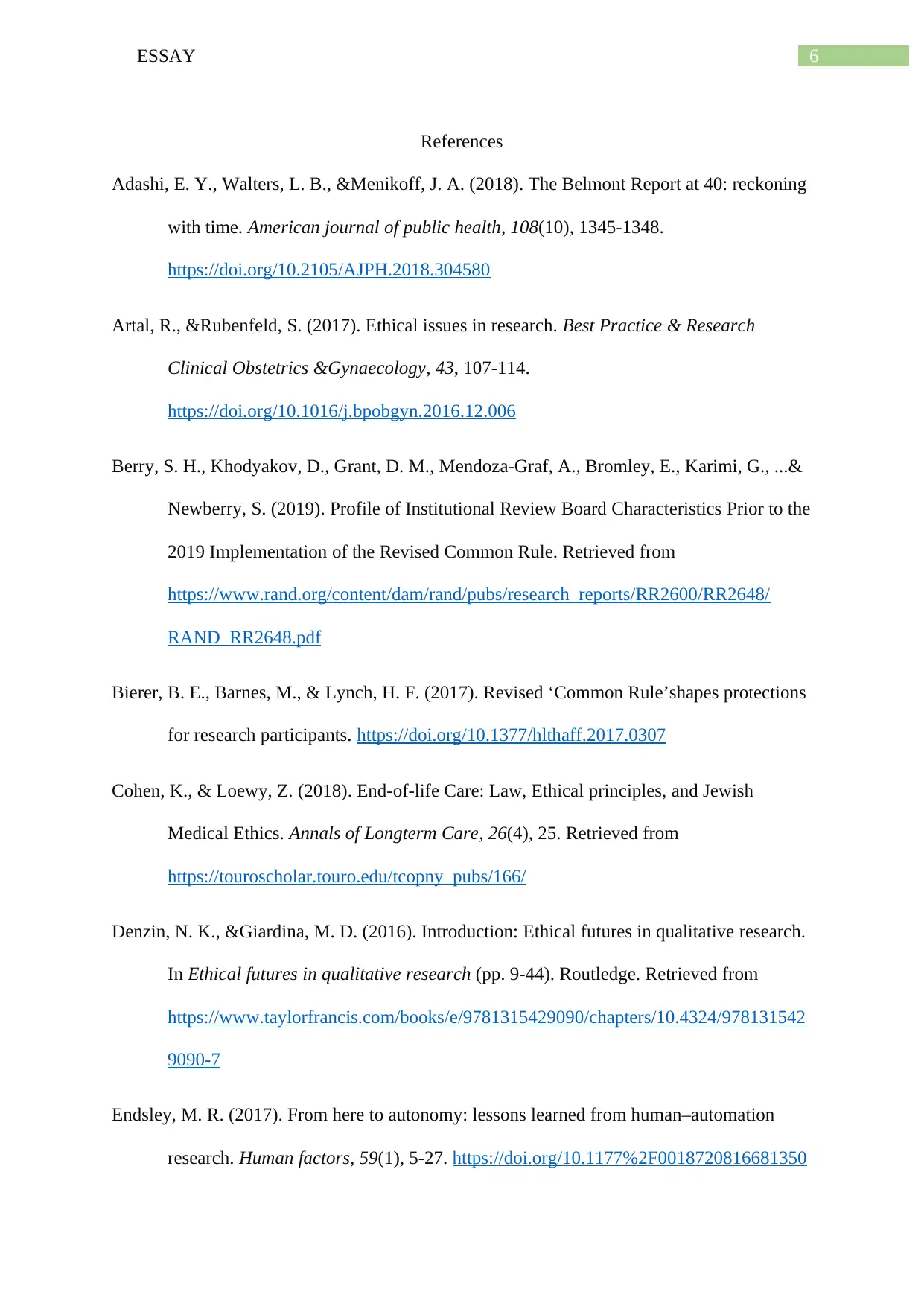
6ESSAY
References
Adashi, E. Y., Walters, L. B., &Menikoff, J. A. (2018). The Belmont Report at 40: reckoning
with time. American journal of public health, 108(10), 1345-1348.
https://doi.org/10.2105/AJPH.2018.304580
Artal, R., &Rubenfeld, S. (2017). Ethical issues in research. Best Practice & Research
Clinical Obstetrics &Gynaecology, 43, 107-114.
https://doi.org/10.1016/j.bpobgyn.2016.12.006
Berry, S. H., Khodyakov, D., Grant, D. M., Mendoza-Graf, A., Bromley, E., Karimi, G., ...&
Newberry, S. (2019). Profile of Institutional Review Board Characteristics Prior to the
2019 Implementation of the Revised Common Rule. Retrieved from
https://www.rand.org/content/dam/rand/pubs/research_reports/RR2600/RR2648/
RAND_RR2648.pdf
Bierer, B. E., Barnes, M., & Lynch, H. F. (2017). Revised ‘Common Rule’shapes protections
for research participants. https://doi.org/10.1377/hlthaff.2017.0307
Cohen, K., & Loewy, Z. (2018). End-of-life Care: Law, Ethical principles, and Jewish
Medical Ethics. Annals of Longterm Care, 26(4), 25. Retrieved from
https://touroscholar.touro.edu/tcopny_pubs/166/
Denzin, N. K., &Giardina, M. D. (2016). Introduction: Ethical futures in qualitative research.
In Ethical futures in qualitative research (pp. 9-44). Routledge. Retrieved from
https://www.taylorfrancis.com/books/e/9781315429090/chapters/10.4324/978131542
9090-7
Endsley, M. R. (2017). From here to autonomy: lessons learned from human–automation
research. Human factors, 59(1), 5-27. https://doi.org/10.1177%2F0018720816681350
References
Adashi, E. Y., Walters, L. B., &Menikoff, J. A. (2018). The Belmont Report at 40: reckoning
with time. American journal of public health, 108(10), 1345-1348.
https://doi.org/10.2105/AJPH.2018.304580
Artal, R., &Rubenfeld, S. (2017). Ethical issues in research. Best Practice & Research
Clinical Obstetrics &Gynaecology, 43, 107-114.
https://doi.org/10.1016/j.bpobgyn.2016.12.006
Berry, S. H., Khodyakov, D., Grant, D. M., Mendoza-Graf, A., Bromley, E., Karimi, G., ...&
Newberry, S. (2019). Profile of Institutional Review Board Characteristics Prior to the
2019 Implementation of the Revised Common Rule. Retrieved from
https://www.rand.org/content/dam/rand/pubs/research_reports/RR2600/RR2648/
RAND_RR2648.pdf
Bierer, B. E., Barnes, M., & Lynch, H. F. (2017). Revised ‘Common Rule’shapes protections
for research participants. https://doi.org/10.1377/hlthaff.2017.0307
Cohen, K., & Loewy, Z. (2018). End-of-life Care: Law, Ethical principles, and Jewish
Medical Ethics. Annals of Longterm Care, 26(4), 25. Retrieved from
https://touroscholar.touro.edu/tcopny_pubs/166/
Denzin, N. K., &Giardina, M. D. (2016). Introduction: Ethical futures in qualitative research.
In Ethical futures in qualitative research (pp. 9-44). Routledge. Retrieved from
https://www.taylorfrancis.com/books/e/9781315429090/chapters/10.4324/978131542
9090-7
Endsley, M. R. (2017). From here to autonomy: lessons learned from human–automation
research. Human factors, 59(1), 5-27. https://doi.org/10.1177%2F0018720816681350
Paraphrase This Document
Need a fresh take? Get an instant paraphrase of this document with our AI Paraphraser
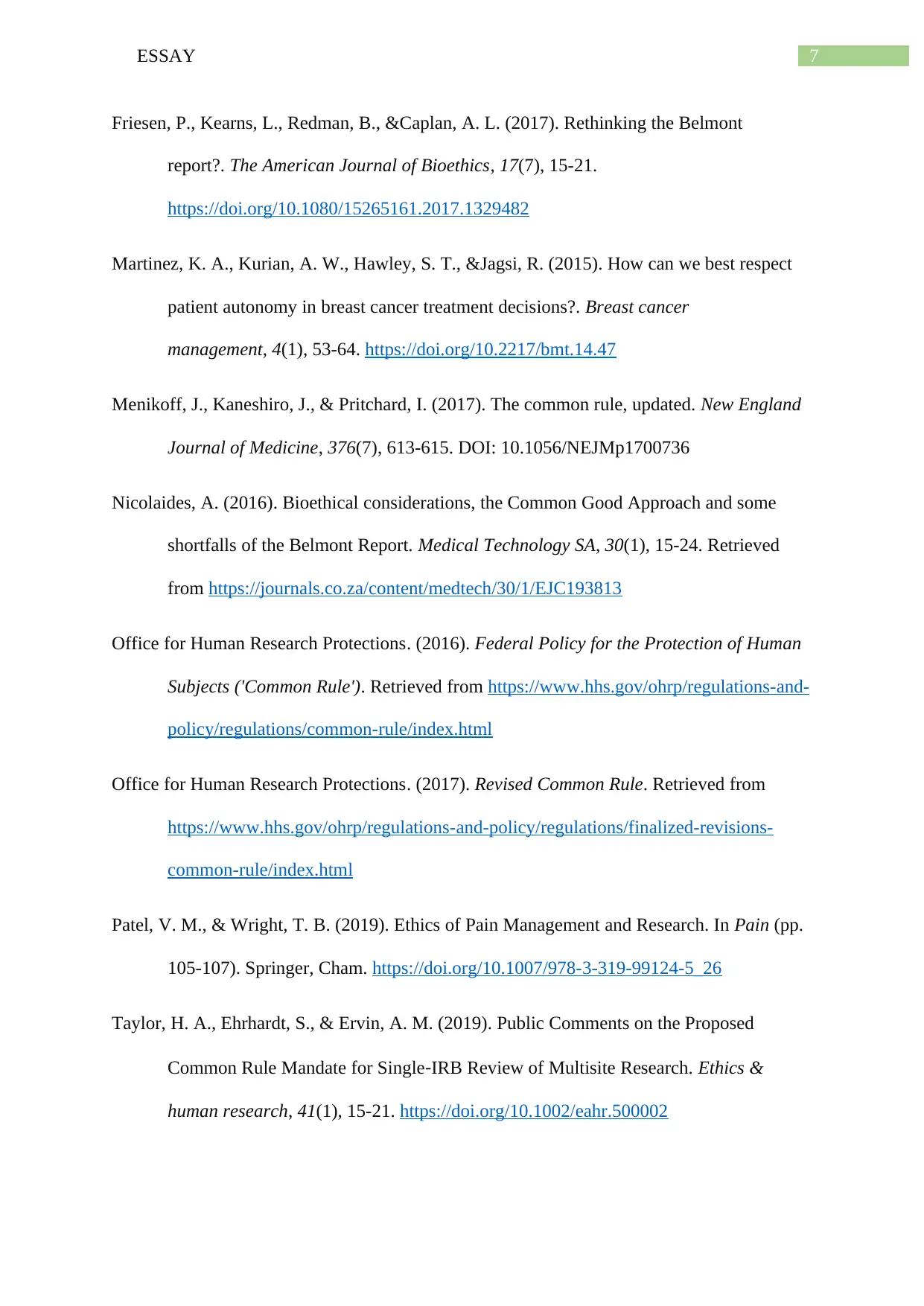
7ESSAY
Friesen, P., Kearns, L., Redman, B., &Caplan, A. L. (2017). Rethinking the Belmont
report?. The American Journal of Bioethics, 17(7), 15-21.
https://doi.org/10.1080/15265161.2017.1329482
Martinez, K. A., Kurian, A. W., Hawley, S. T., &Jagsi, R. (2015). How can we best respect
patient autonomy in breast cancer treatment decisions?. Breast cancer
management, 4(1), 53-64. https://doi.org/10.2217/bmt.14.47
Menikoff, J., Kaneshiro, J., & Pritchard, I. (2017). The common rule, updated. New England
Journal of Medicine, 376(7), 613-615. DOI: 10.1056/NEJMp1700736
Nicolaides, A. (2016). Bioethical considerations, the Common Good Approach and some
shortfalls of the Belmont Report. Medical Technology SA, 30(1), 15-24. Retrieved
from https://journals.co.za/content/medtech/30/1/EJC193813
Office for Human Research Protections. (2016). Federal Policy for the Protection of Human
Subjects ('Common Rule'). Retrieved from https://www.hhs.gov/ohrp/regulations-and-
policy/regulations/common-rule/index.html
Office for Human Research Protections. (2017). Revised Common Rule. Retrieved from
https://www.hhs.gov/ohrp/regulations-and-policy/regulations/finalized-revisions-
common-rule/index.html
Patel, V. M., & Wright, T. B. (2019). Ethics of Pain Management and Research. In Pain (pp.
105-107). Springer, Cham. https://doi.org/10.1007/978-3-319-99124-5_26
Taylor, H. A., Ehrhardt, S., & Ervin, A. M. (2019). Public Comments on the Proposed
Common Rule Mandate for Single‐IRB Review of Multisite Research. Ethics &
human research, 41(1), 15-21. https://doi.org/10.1002/eahr.500002
Friesen, P., Kearns, L., Redman, B., &Caplan, A. L. (2017). Rethinking the Belmont
report?. The American Journal of Bioethics, 17(7), 15-21.
https://doi.org/10.1080/15265161.2017.1329482
Martinez, K. A., Kurian, A. W., Hawley, S. T., &Jagsi, R. (2015). How can we best respect
patient autonomy in breast cancer treatment decisions?. Breast cancer
management, 4(1), 53-64. https://doi.org/10.2217/bmt.14.47
Menikoff, J., Kaneshiro, J., & Pritchard, I. (2017). The common rule, updated. New England
Journal of Medicine, 376(7), 613-615. DOI: 10.1056/NEJMp1700736
Nicolaides, A. (2016). Bioethical considerations, the Common Good Approach and some
shortfalls of the Belmont Report. Medical Technology SA, 30(1), 15-24. Retrieved
from https://journals.co.za/content/medtech/30/1/EJC193813
Office for Human Research Protections. (2016). Federal Policy for the Protection of Human
Subjects ('Common Rule'). Retrieved from https://www.hhs.gov/ohrp/regulations-and-
policy/regulations/common-rule/index.html
Office for Human Research Protections. (2017). Revised Common Rule. Retrieved from
https://www.hhs.gov/ohrp/regulations-and-policy/regulations/finalized-revisions-
common-rule/index.html
Patel, V. M., & Wright, T. B. (2019). Ethics of Pain Management and Research. In Pain (pp.
105-107). Springer, Cham. https://doi.org/10.1007/978-3-319-99124-5_26
Taylor, H. A., Ehrhardt, S., & Ervin, A. M. (2019). Public Comments on the Proposed
Common Rule Mandate for Single‐IRB Review of Multisite Research. Ethics &
human research, 41(1), 15-21. https://doi.org/10.1002/eahr.500002
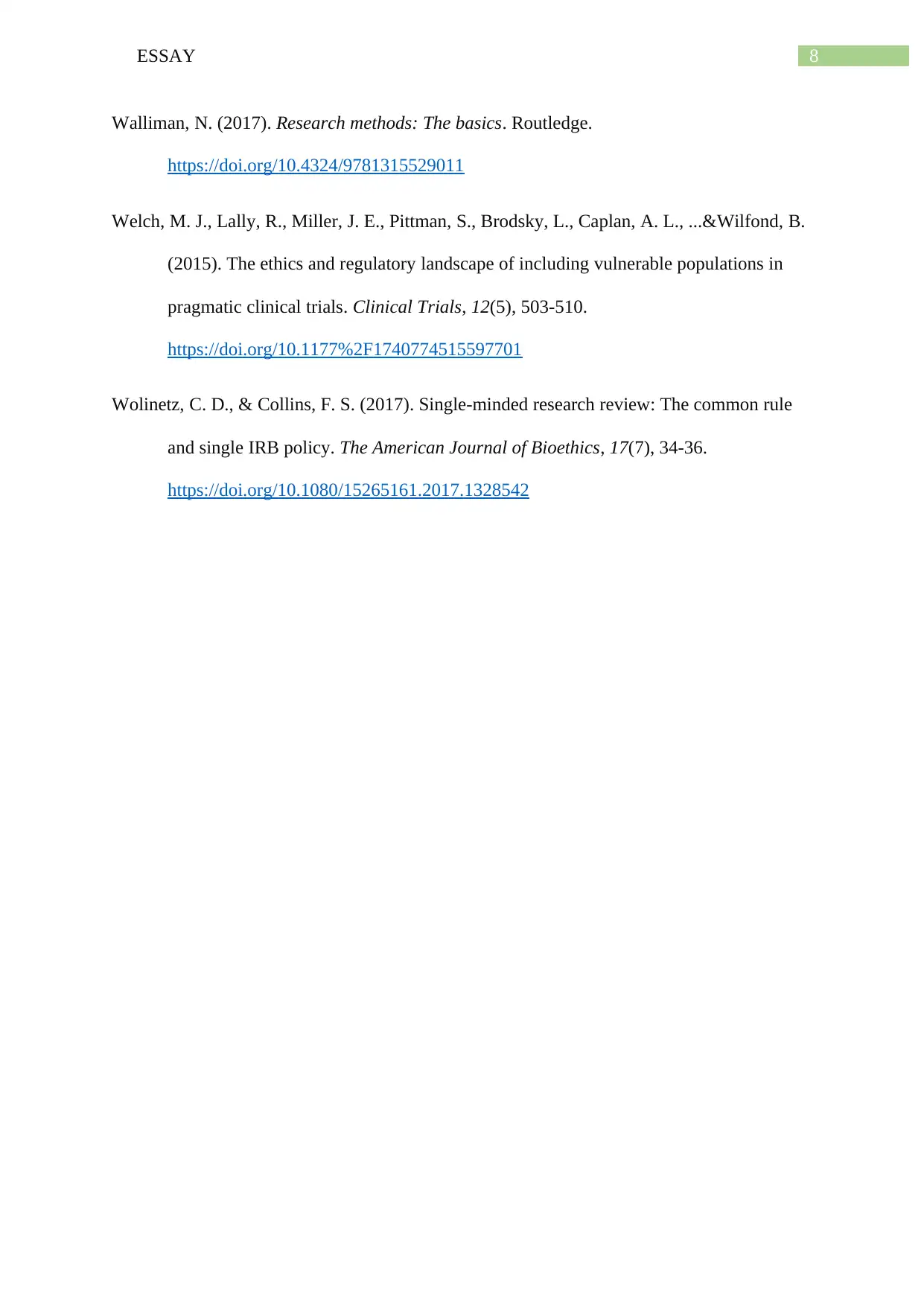
8ESSAY
Walliman, N. (2017). Research methods: The basics. Routledge.
https://doi.org/10.4324/9781315529011
Welch, M. J., Lally, R., Miller, J. E., Pittman, S., Brodsky, L., Caplan, A. L., ...&Wilfond, B.
(2015). The ethics and regulatory landscape of including vulnerable populations in
pragmatic clinical trials. Clinical Trials, 12(5), 503-510.
https://doi.org/10.1177%2F1740774515597701
Wolinetz, C. D., & Collins, F. S. (2017). Single-minded research review: The common rule
and single IRB policy. The American Journal of Bioethics, 17(7), 34-36.
https://doi.org/10.1080/15265161.2017.1328542
Walliman, N. (2017). Research methods: The basics. Routledge.
https://doi.org/10.4324/9781315529011
Welch, M. J., Lally, R., Miller, J. E., Pittman, S., Brodsky, L., Caplan, A. L., ...&Wilfond, B.
(2015). The ethics and regulatory landscape of including vulnerable populations in
pragmatic clinical trials. Clinical Trials, 12(5), 503-510.
https://doi.org/10.1177%2F1740774515597701
Wolinetz, C. D., & Collins, F. S. (2017). Single-minded research review: The common rule
and single IRB policy. The American Journal of Bioethics, 17(7), 34-36.
https://doi.org/10.1080/15265161.2017.1328542
⊘ This is a preview!⊘
Do you want full access?
Subscribe today to unlock all pages.

Trusted by 1+ million students worldwide
1 out of 9
Related Documents
Your All-in-One AI-Powered Toolkit for Academic Success.
+13062052269
info@desklib.com
Available 24*7 on WhatsApp / Email
![[object Object]](/_next/static/media/star-bottom.7253800d.svg)
Unlock your academic potential
Copyright © 2020–2025 A2Z Services. All Rights Reserved. Developed and managed by ZUCOL.





